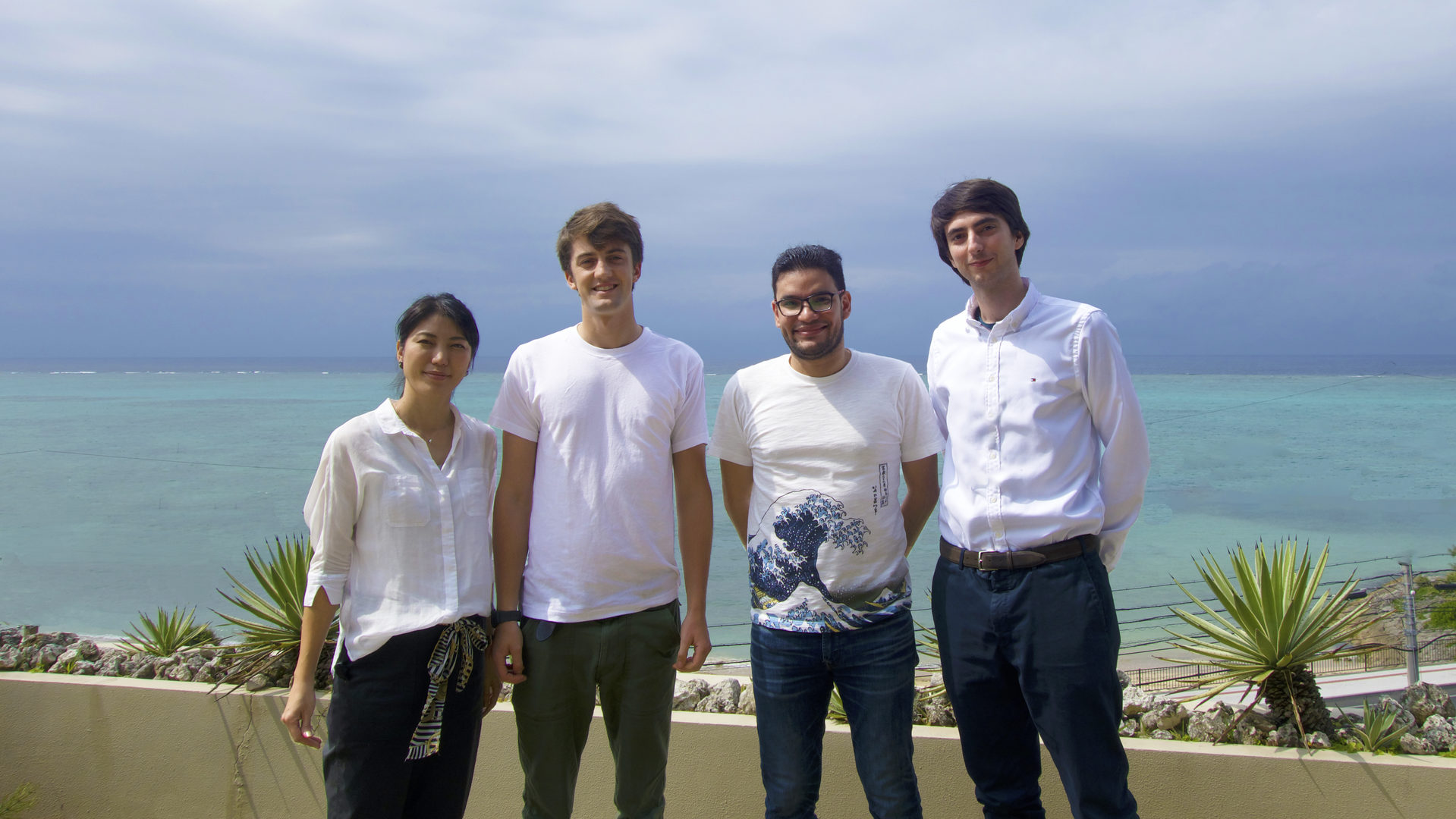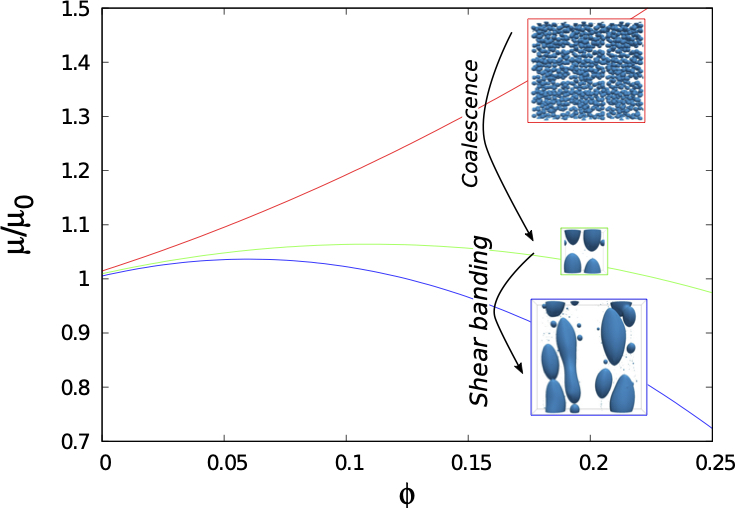FY2019 Annual Report
Complex Fluids and Flows Unit
Assistant Professor - Marco Edoardo Rosti

Abstract
The Complex Fluids and Flows Unit (CFFU) was established in January 2020 when Marco Edoardo Rosti moved from the University of Tokyo, Japan. While continuing existing research activities, several new interdisciplinary research projects have been initiated at OIST in collaboration with researchers outside OIST.
The Unit research has focused on multiphase systems in various flow configurations. First, we have studied the deformation, coalescence and breakup of droplets in shear flows at moderately low Reynolds numbers. We aim to understand and fully characterize the conditions leading to droplet breakup and coalescence in both Newtonian and non-Newtonian fluids. At the same time, the same problem has been investigated in a turbulent flow condition in order to understand the effect of the dispersed phase on turbulence. One major new research field started this year: on one hand, we have studied the modification of turbulence due to the presence of fiber-like objects to model the flow within canopies or porous media, and on the other hand, we have proposed and tested a novel technique to measure turbulence statistical properties based on the tracking of a dilute suspension of fibers.
In the current period, the Unit welcomed Mr. Ianto Cannon as a PhD student and Mr. Mohamed Abdelgawad as a rotation student.
1. Staff
- Mr. Ianto Cannon, Graduate Student
- Mr. Mohamed Abdelgawad, Rotation Student
- Ms. Megumi Ikeda, Administrative Assistant
2. Collaborations
2.1 Particle laden flows in non-Newtonian fluids
- Type of collaboration: Joint research
- Researchers:
- Prof. Luca Brandt, KTH Royal Institute of Technology
- Prof. Massimiliano Villone, University of Naples Federico II
- Prof. Marco Rosti, OIST
2.2 Fibers in turbulent flows
- Type of collaboration: Joint research
- Researchers:
- Prof. Andrea Mazzino, University of Genova
- Mr. Stefano Olivieri, University of Genova
- Prof. Marco Rosti, OIST
2.3 Numerical methods to simulate three-phase flows
- Type of collaboration: Joint research
- Researchers:
- Prof. Shu Takagi, The University of Tokyo
- Mr. Naoki Hori, The University of Tokyo
- Prof. Marco Rosti, OIST
2.4 The effect of porous walls on particle suspensions
- Type of collaboration: Joint research
- Researchers:
- Prof. Parisa Mirbod, University of Illinois at Chicago
- Prof. Luca Brandt, KTH Royal Institute of Technology
- Prof. Marco Rosti, OIST
2.5 Haemorheology of Red Blood Cells
- Type of collaboration: Joint research
- Researchers:
- Prof. Naoki Takeishi, Osaka University
- Prof. Marco Rosti, OIST
3. Activities and Findings
3.1 Emulsions in shear flows
Multiphase shear flows often show banded structures that affect the global behavior of complex fluids e.g. in microdevices. We investigated numerically the banding of emulsions, i.e. the formation of regions of high and low volume fraction, alternated in the vorticity direction and aligned with the flow (shear bands). These bands are associated with a decrease of the effective viscosity of the system. We found that the initial banded distribution is stable when droplets are free to merge and unstable when coalescence is prevented. In this case, additionally, the effective viscosity of the system increases, resembling the rheological behavior of suspensions of deformable particles. Droplets coalescence, on the other hand, allows emulsions to reduce the total surface of the system and hence the energy dissipation associated to the deformation, which in turn reduces the effective viscosity.

3.2 Turbulence in a network of fibers
The effect of a network of fixed rigid fibers on fluid flow was investigated by means of three-dimensional direct numerical simulations using an immersed boundary method for the fluid-structure coupling. Different flows are considered (i.e., cellular, parallel and homogeneous isotropic turbulent flows) in order to identify the main mechanisms occurring within canopies or fibrous media, as well as particle-laden flows. First, we investigate the stabilizing effect of the network on the Arnold-Beltrami-Childress (ABC) cellular flow, showing that, the steady configuration obtained for a sufficiently large fiber concentration mimics the single-phase stable solution at a lower Reynolds number. Focusing on the large-scale dynamics, the effect of drag exerted by the network on the flow can be effectively modelled by means of a Darcy’s friction term. For the latter, we propose a phenomenological expression that is corroborated when extending our analysis to the Kolmogorov parallel flow and homogeneous isotropic turbulence. Furthermore, we examine the overall energy distribution across the various scales of motion, highlighting the presence of small-scale activity with a peak in the energy spectra occurring at the wavenumber corresponding to the network spacing.

Figure 2: Energy spectra in cellular flows for different fiber concentrations and lengths. The spectra are normalized using a Darcy-like argument while the independent variable using the network wavenumber.
4. Publications
4.1 Journals
- Numerical simulations of vorticity banding of emulsions in shear flows
F. De Vita, M. E. Rosti, S. Caserta, L. Brandt
Soft Matter, The Royal Society of Chemistry, Advance Article, (2020)
DOI: 10.1039/C9SM01898K
4.2 Books and other one-time publications
Nothing to report
4.3 Oral and Poster Presentations
- M. E. Rosti, The effect of elastic and porous walls on the rheology of suspensions.
Mini-symposium on Fluid-Structure Interactions: From Engineering to Biomimetic Systems
OIST, Okinawa, Japan, 16 Jan (2019).
5. Intellectual Property Rights and Other Specific Achievements
Nothing to report
6. Meetings and Events
6.1 Lagrangian fiber tracking as a way to measure two-point properties of fluid flow
- February 3, 2020
- Venue: OIST Campus D014
- Speaker: Mr. Stefano Olivieri (University of Genova)
7. Other
Nothing to report.



